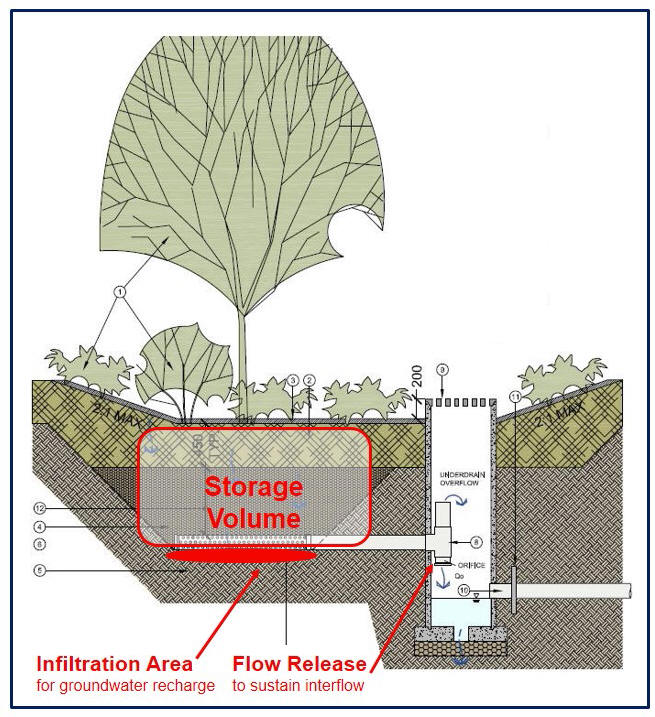“The innovation of the Water Balance Methodology is in the integration and application of proven scientific and engineering principles," says Jim Dumont
Note to Reader:
In February 2014, the Partnership for Water Sustainability in BC released the Primer on the Water Balance Methodology for Protecting Watershed Health. This is the fifth in the Beyond the Guidebook Primer Series.
The Partnership’s purpose in developing the Primers is to inform and educate infrastructure, land use and environmental professionals about implementing actions at the site scale that will achieve desired outcomes at the watershed scale.

Look at Rainfall Differently
“In 2002, looking at rainfall differently led the Province of British Columbia to adopt the Water Balance Methodology, initiate a performance target approach to capturing rain where it falls, and initiate changes in the ways rainwater runoff is returned to streams,” states Kim Stephens, Executive Director of the Partnership for Water Sustainability in BC.
 “The Province’s decision to embed the Water Balance Methodology in Stormwater Planning: A Guidebook for British Columbia defined a turning point in the regulatory vision for drainage planning, and that is: ‘design with nature’ and forestall problems rather than reacting to problems after they have occurred.” Kim Stephens was project manager and principal author of the Guidebook, released in 2002.
“The Province’s decision to embed the Water Balance Methodology in Stormwater Planning: A Guidebook for British Columbia defined a turning point in the regulatory vision for drainage planning, and that is: ‘design with nature’ and forestall problems rather than reacting to problems after they have occurred.” Kim Stephens was project manager and principal author of the Guidebook, released in 2002.
Beyond the Guidebook Primer Series
The Beyond the Guidebook Primer Series builds on the Guidebook foundation, adds depth regarding core concepts, and supports implementation of targets and actions listed in Living Water Smart: British Columbia’s Water Plan. The targets and actions establish expectations as to how land will be (re)developed so that stream and watershed health are protected and/or restored.
“The fifth in the Series describes the science-based Water Balance Methodology that integrates engineering and biophysical understanding so that communities can implement Watershed-based Targets that ‘mimic the Natural Water Balance’ and thereby restore and/or protect Watershed Health after the Natural Environment is altered by human activities,” states Kim Stephens.
Mimic the Water Balance – How?
 “Protection of watershed and stream health ultimately involves maintaining the natural proportion of rainwater entering streams via three pathways: surface flow, interflow (shallow sub-surface flow), and groundwater flow,” continues Jim Dumont. He is the Engineering Applications Authority for the Partnership for Water Sustainability in British Columbia.
“Protection of watershed and stream health ultimately involves maintaining the natural proportion of rainwater entering streams via three pathways: surface flow, interflow (shallow sub-surface flow), and groundwater flow,” continues Jim Dumont. He is the Engineering Applications Authority for the Partnership for Water Sustainability in British Columbia.
“The Water Balance Methodology examines the flow paths of water in the watershed, and the flow in streams. To replicate natural processes, it is necessary to establish performance targets that define how to ‘slow, sink and spread’ rainwater.”
Water Balance Methodology
“At the heart of the Water Balance Methodology is recognition of the integrated significance of these three flow paths, the period of time required for rainwater to reach the stream via each flow path, and the need to protect and maintain the natural distribution of rainwater via each flow path,” continues Jim Dumont.
“The Water Balance Methodology addresses the flow path differences, and provides solutions that would maintain stream health within a developed watershed.”
“Now, the Primer on the Water Balance Methodology for Protecting Watershed Health provides local governments with ‘how-to-apply-it’ guidance so that they can establish three performance targets for integrated design of rainwater management systems. These are storage volume, infiltration area and flow release rate.”
Comparison with Prescriptive Approaches
“The Water Balance Methodology provides a much greater degree of certainty than a prescriptive approach which only calls for capture of rainwater,” emphasizes Jim Dumont.
“Of all the information and words about stream and watershed health, the following statement distils the reasons why I am so passionate about advancing engineering in step with the other sciences:
- The Water Balance Methodology provides a logical and straightforward way to assess potential impacts resulting from urban development; and analytically demonstrate the effectiveness of the methods proposed for preventing and/or mitigating those impacts.”
“If the stream flows and durations of flow can be maintained without increasing the magnitude and duration of above average stream discharges, then success can be demonstrated.”
 “The innovation of the Water Balance Methodology is in the integration and application of proven scientific and engineering principles. Breakthroughs in science-based understanding occurred in the mid-1990s. Yet engineering practice generally did not incorporate this understanding. The Water Balance Methodology has addressed this historical oversight and is being enhanced over time to incorporate fresh insights,” concludes Jim Dumont.
“The innovation of the Water Balance Methodology is in the integration and application of proven scientific and engineering principles. Breakthroughs in science-based understanding occurred in the mid-1990s. Yet engineering practice generally did not incorporate this understanding. The Water Balance Methodology has addressed this historical oversight and is being enhanced over time to incorporate fresh insights,” concludes Jim Dumont.
To Learn More:
To download a copy, click on Primer on Water Balance Methodology for Protecting Watershed Health. The Primer storyline is structured in five parts:
- Part A: Watershed-Based Approach to Rainwater Management
- Part B: Water Balance Methodology Explained
- Part C: Science Behind the Methodology
- Part D: How to Establish Targets
- Part E: References
Landscape-based solutions would allow each property in a neighbourhood to capture, store and slowly release the right proportion of rainwater into the ground to replenish aquifers and streams. Illustrated below is a rain garden, which is a typical application.

How Performance Targets for Storage, Infiltration and Flow Release are incorporated in a Rain Garden Design <image source: “Stormwater Source Control Design Guidelines 2012 (Final Report), Metro Vancouver, British Columbia>

